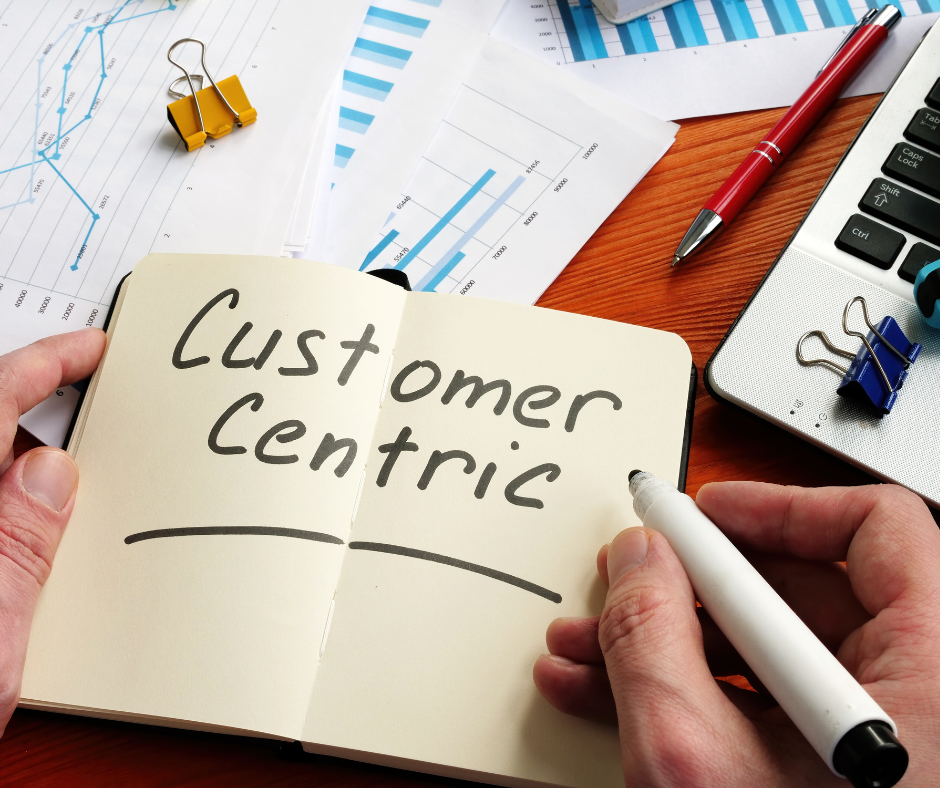According to a study by Salesforce, 85% of business buyers and 79% of consumers said that the experience a company provides is as important as its products and services. Meanwhile, according to a survey by PWC, 78% of customers are willing to pay more for an excellent customer experience. 40% of customers will switch to a competitor after just one bad experience and 70% of buying experiences are based on how customers feel they are being treated.
In businesses, customer experience leaders grow revenues four to eight times faster than their peers. It is seen that companies that invest in customer experience outperform the market by 17%.
In this article, let us learn more about what it means to be customer-centric:
- What does it mean to be Customer-Centric?
- Why is Customer-Centricity important for Brands?
- What does a Customer-Centric Organization look like?
- What is the Value of a Customer-Centric Culture?
- What is Customer-Centric Marketing?
- What is Customer-Centric Selling ?
- How to create a Customer-Centric Experience?
- What are some of Customer-Centric Company Examples?
- How to Become a Customer-Centric Company?
- How Deskera Can Assist You?
- Key Takeaways
- Related Articles
What does it mean to be Customer-Centric?
Customer-centricity is a business model or philosophy that puts customers at the center of all decisions. This means that customer needs and desires are taken into consideration before any decision is made. The goal is to provide customers with an exceptional experience that results in loyalty and long-term relationships. This approach requires businesses to be customer-focused and customer-driven, as well as to create personalized experiences for customers.
Why is Customer-Centricity important for Brands?
Customer-centricity is important for brands because it helps to create customer loyalty and trust. Customers who receive an exceptional customer experience are more likely to return and purchase from the same company again, as well as recommend the company to others. As a result, customer-centric companies are likely to see increased revenue and a better bottom line.
Being customer-centric can provide a wide range of benefits to businesses, including:
• Increased customer loyalty and retention
• Increased revenue
• Increased customer engagement
• Improved customer service
• Increased brand awareness
• Improved customer experience
• Easier customer onboarding
• Improved customer relationships
What does a Customer-Centric Organization look like?
A customer-centric organization is one that puts the customer first in all decisions and activities. All employees understand the importance of customer satisfaction and are held accountable for providing exceptional customer service. The organization deeply understands the customer, including their needs, preferences, and behaviors. The organization also focuses on customer feedback and uses customer insights to inform decisions and activities.
Creating a customer-centric culture starts with the leadership team. The leadership team should have a clear customer-centric strategy and mission that everyone in the organization can understand and get behind. This strategy should be communicated to all employees and should be the driving force behind all decision-making. Additionally, the leadership team should focus on customer feedback and use it to inform decisions, as well as reward employees who provide exceptional customer service.
What is the Value of a Customer-Centric Culture?
Creating a customer-centric culture is essential for businesses to stay competitive in today’s market. A customer-centric culture puts the customer at the center of all decisions and activities. This creates a customer-first mentality that improves customer service and customer experience. Additionally, it allows businesses to understand their customers better and create more personalized experiences.
What is Customer-Centric Marketing?
Customer-centric marketing is a type of marketing strategy that puts customers at the center of all decisions. This means that customer needs and desires are taken into consideration before any decision is made. The goal is to provide customers with an exceptional experience that results in loyalty and long-term relationships. This approach requires businesses to be customer-focused and customer-driven, as well as to create personalized experiences for customers.
What is Customer-Centric Selling ?
Customer-centric selling is a type of sales strategy that places customers at the center of all decisions. The goal is to understand the customer’s needs and wants, and to create solutions that will meet those needs. This approach focuses on building relationships with customers, understanding their needs, and providing solutions that will help them achieve their goals. Customer-centric selling helps businesses create long-term customer relationships and increase customer satisfaction.
Steps toward a customer-centric future Creating a customer-centric organization is not a one-time effort – it’s a continuous journey.
Here are some steps businesses can take to move toward a customer-centric future:
• Understand your customers: Know who your customers are and what their needs are.
• Focus on customer feedback: Listen to what your customers are saying and use it to inform decisions.
• Create personalized experiences: Make sure your customers feel valued by personalizing their interactions with your business.
• Analyze customer data: Use customer data to understand customer behavior and preferences.
• Invest in customer service: Invest in your customer service team and make sure they are well-trained and equipped to provide exceptional customer service.
• Embrace technology: Use technology to create more connected experiences for your customers.
How to create a Customer-Centric Experience?
1. Identify Your Customers: Understanding your customers is the first and most important step in creating a customer-centric experience. Take the time to get to know who your customers are, what their needs are, and how they prefer to interact with your business.
2. Develop a Plan: Once you’ve identified your customers and their needs, it’s time to develop a plan to make sure their experience is as positive as possible. This plan should include elements such as customer service, product design, and marketing.
3. Focus on the Customer: At the core of a customer-centric experience is the customer. Make sure you are focused on the customer’s needs and wants and that you are providing them with the best possible experience.
4. Provide Quality Service: Quality customer service is a must for creating a customer-centric experience. Make sure your staff is trained to provide customers with the best possible service and that they understand the importance of customer satisfaction.
5. Personalize the Experience: Personalization is key when it comes to creating a customer-centric experience. Take the time to get to know your customers and follow up with them after their purchase or interaction.
6. Use Technology: Technology can be a powerful tool for creating a customer-centric experience. Use technology to provide customers with a personalized experience and make it easier for them to interact with your business.
What are some of Customer-Centric Company Examples?
• Amazon: Amazon has made its name by providing customers with an exceptional experience. From its personalized recommendations to its convenient delivery options, Amazon has made it easy for customers to find what they’re looking for and get it quickly.
• Zappos: Zappos is known for its excellent customer service and its commitment to making customers happy. Zappos stands out by offering free shipping, 365-day returns, and 24/7 customer service.
• Apple: Apple puts customers at the center of everything they do, from product design to customer service. With its sleek design and intuitive interfaces, Apple products make customers feel like they’re getting something special.
• Uber: Uber has created a customer-centric experience by making it easy to get a ride quickly and easily. Customers can easily book a ride from their phones and track their driver in real-time.
How to Become a Customer-Centric Company?
Creating a customer-centric organization is not a one-time effort – it’s a continuous journey.
Here are some steps businesses can take to become a customer-centric company:
• Understand your customers: Know who your customers are and what their needs are.
• Focus on customer feedback: Listen to what your customers are saying and use it to inform decisions.
• Create personalized experiences: Make sure your customers feel valued by personalizing their interactions with your business.
• Analyze customer data: Use customer data to understand customer behavior and preferences.
• Invest in customer service: Invest in your customer service team and make sure they are well-trained and equipped to provide exceptional customer service.
• Embrace technology: Use technology to create more connected experiences for your customers.
3 Ways to Measure the Success of a Customer-Centric Company
1. Customer Satisfaction: Assess customer satisfaction through surveys, focus groups, and other feedback from customers. Look out for customer complaints and address them in a timely manner.
2. Customer Retention: Measure the customer retention rate to determine if customers are staying with the company over time. This indicates that customers are loyal and satisfied with the company’s products and services.
3. Revenue Growth: Analyze the revenue growth of the company, while considering customer lifetime value. This will show how successful the company is in increasing customer loyalty and gaining new customers.
How Deskera Can Assist You?
Whether you are a sales manager or running your own business, there are tons of duties and responsibilities that you have to fulfill. Using the Deskera CRM system, you can manage your contacts, leads and sales deals. You can use the CRM system to manage all customer data and manage your leads, sales negotiations and deals.
Doing so will help you to save the time taken in transferring customer data between the different systems. Having a good CRM system will help you manage your financial and sales reports and be prepared to kick-off your meetings.
Deskera can also assist you with real-time updates about your business like cash flow status, customer satisfaction, inventory management, sales, purchases, purchase orders, customer tickets, customer satisfaction, managing leads, revenues, profit, and loss statements, and balance sheets.
Moreover, it would also help in integrating sales methodology across different platforms onto one system so that you have a consolidated list for email campaigns, leads management, and sales pipeline to mention a few.
It will also help you to sync between your orders, payments, taxes, refunds, product variants, sending out invoices and reminders, facilitating invoice management, and even undertaking follow-ups and advertisement campaigns.
Such a consolidated platform will help you to improve your sales through building effective sales compensation plans and also facilitate faster and well-informed decision-making. It will help you in strengthening your opportunities and being braced for the threats.
Key Takeaways
Customer centric business is a type of business model that focuses on creating products and services that meet the needs and desires of customers.
It is based on the idea of putting customers at the center of everything a company does, from product design to customer service. This approach involves gathering data from customers to understand their needs and preferences, and using this information to inform decisions about product development and marketing.
Additionally, customer centric businesses focus on creating a positive experience for customers, both online and offline. This includes providing helpful customer service, creating a positive brand image, and developing loyalty programs.
The shift towards becoming a truly customer-centric organization is both complex and long.
However, do not be put off by this as even the smallest changes to policy and processes can have a significant benefit for both employee and your customer.
Being a customer-centric organization is the Holy Grail towards unlocking the true potential of customer value. Always put yourself in the shoes of the customer and minimize customer effort and maximize customer value.
Related Articles











